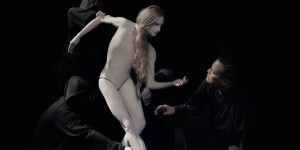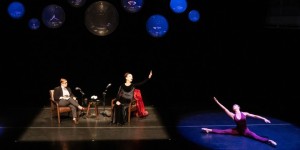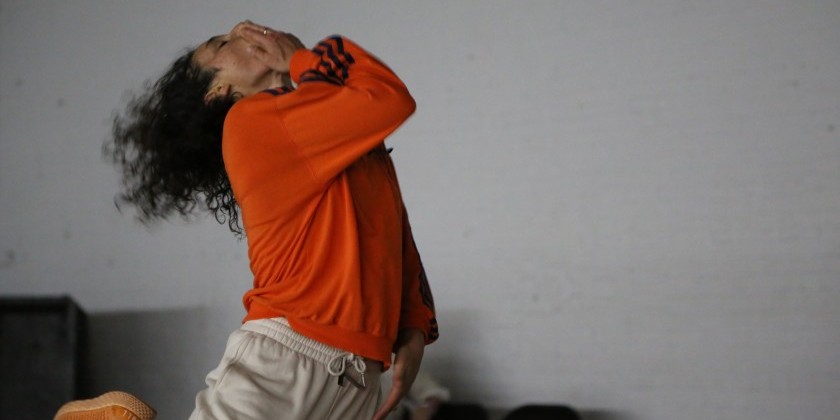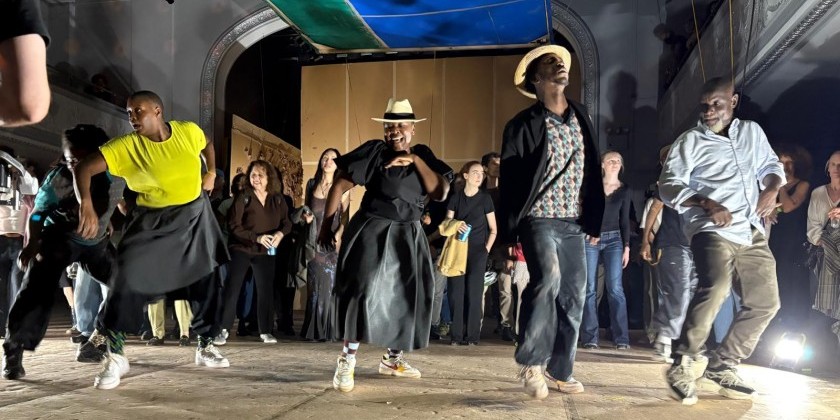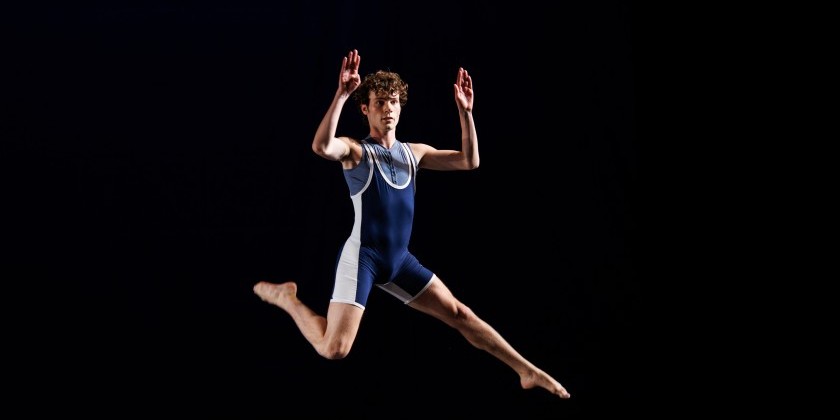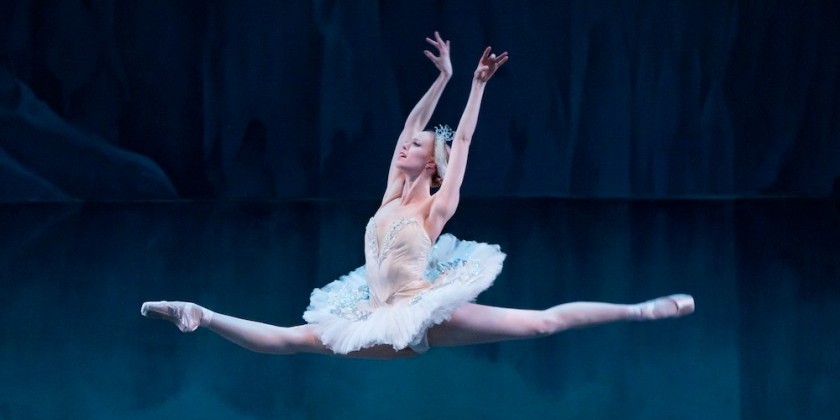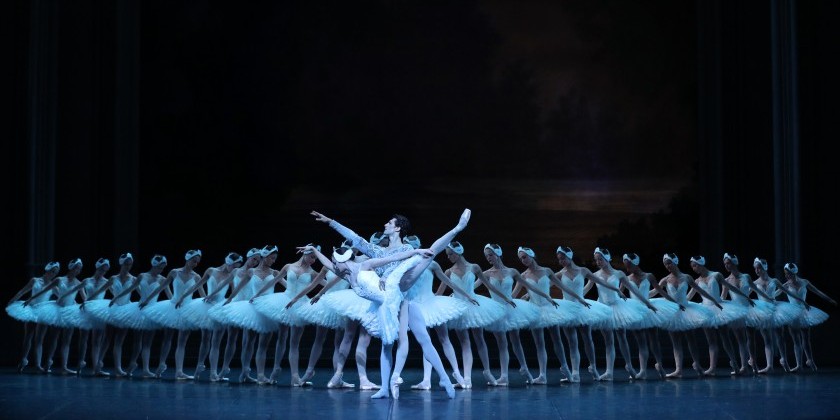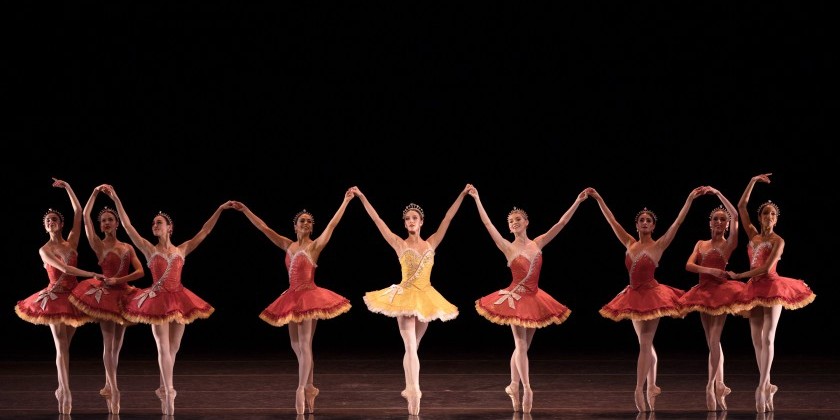Impressions of the Chamber Dance/Opera "Hagoromo"
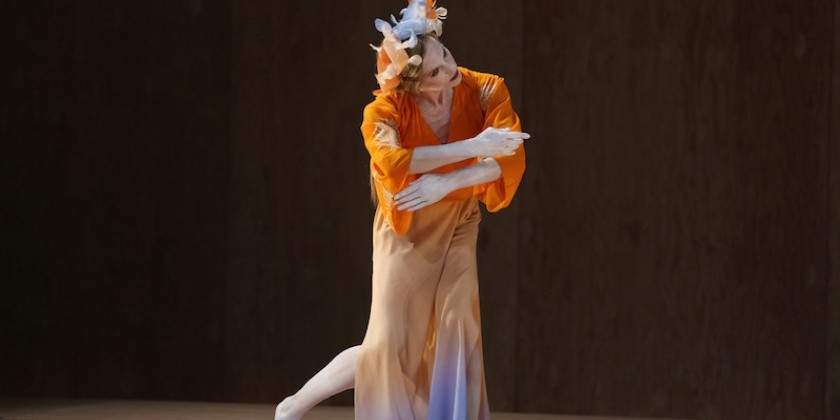
Reawakening the 600-year-old Japanese Noh Play
BAM Harvey Theater/ November 3, 2015
Music by Nathan Davis / Libretto by Brendan Pelsue
Choreography by David Neumann / Puppetry by Chris M. Green
Conducted by Nicholas DeMaison / Conceived and directed by David Michalek
Danced by: Wendy Whelan and Jock Soto
Sung by: Katalin Károlyi (contralto), Peter Tantsits (tenor) and the Brooklyn Youth Chorus
Musicians: International Contemporary Ensemble
The chamber dance/opera Hagoromo, based on a 600-year-old Japanese Noh play, unfolds with strikingly beautiful imagery and a grave, dreamlike slowness. Mingling Western and Eastern elements, the work stays true to Noh’s stripped-down, ultra-refined aesthetic even as it strikes out in decidedly contemporary directions.
The Noh drama that inspired this production was written by Zeami (born 1363), a Japanese actor and playwright. Its libretto tells the story of an angel who loses her hagoromo, a celestial feather robe that enables her not only to fly but also to perform the Dance of the Moon, a ritual dance essential to the lunar cycle. A poor fisherman, Hakuryo, finds the robe and wants it for himself, which sets in motion the libretto’s central action.
In a note that appears in the program, director David Michalek, who also conceived the project, says he rediscovered Hagoromo in a collection of Noh plays translated by Ezra Pound. He writes: “After reading it, I began to imagine how the characters of the Angel and Fisherman could be uniquely inhabited by the dancers Wendy Whelan and Jock Soto... Like the Angel and Fisherman, Jock and Wendy embody elemental opposites, earth and sky, solid assurance and airy grace.”
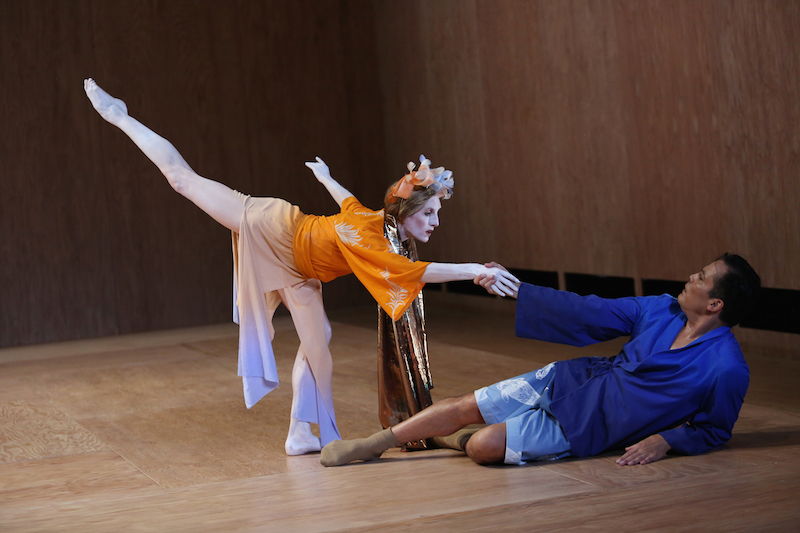
Michalek should know. Whelan, a beloved former New York City Ballet principal, is his wife and, in this production, clearly a muse. She and Soto had a famous partnership at NYCB until Soto retired in 2005. In Hagoromo, which brings them together onstage for the first time in 10 years, their rapport seems as strong as ever.
Whelan and Soto aren’t the only stars here, however. Hagoromo unites leading figures in several disciplines. The work, which Michalek calls a “chamber dance/opera,” features choreography by David Neumann, costumes by Belgian fashion designer Dries Van Noten, puppets by Chris M. Green, and a commissioned score by Nathan Davis. Five musicians from the esteemed International Contemporary Ensemble play Davis’s score out of the spotlight. Joining them are contralto Katalin Károlyi (singing the Angel’s dialogue) and tenor Peter Tantsits (as the Fisherman), seasoned veterans of the global opera house circuit. The lion’s share of the singing in this production (as in traditional Noh) is performed, however, by the chorus, here composed of 20 young girls and teenagers in the highly regarded Brooklyn Youth Chorus.
I was initially skeptical about Van Noten’s inclusion—couturiers rarely make good costume designers. But the Antwerp-based designer’s creations won me over. Van Noten has a solid grasp of the need for costumes to express character and so created very different designs for the mortal beings and the celestial ones. He is also a marvelous colorist. The chorus members, singing from a balcony above the stage like angels themselves, wear silk kimonos the color of cherry blossoms. Whelan wears a gorgeous long silk dress of pale orange fading to blue. It has the look of Japanese traditional dress, but unlike a kimono, allows her body to move freely. A crown of silk flowers lends a touch of fantastical elegance. Van Noten’s design for the hagoromo itself is also quite effective—he conceives of it not as a garment, but as a silken material made of gold threads on one side and copper-toned ones on the other. Draped over Whelan’s body, it becomes a luminous covering; in the hands of the Fisherman, it remains just a piece of golden cloth. This recalls a line in the libretto where the angel tells Hakuryo that the cloak “is not fit for mortals but for a sky-traversing spirit.”
The set design (by Sara Brown) and lighting (Clifton Taylor) also contribute to the visual richness of this production. Brown’s blond-wood set is a replica of the traditional Noh stage, defining the space as a three-sided box open to the audience. This simplicity has a profound beauty. Beauty-in-simplicity is one of the secrets of Noh’s power, as well as its aesthetic ideal. Brown’s set also features a stage element that’s not part of traditional productions of Hagoromo: Early in the drama, two black-clad puppeteers approach the back stage wall and open two semi-circular-shaped doors carved into its surface. Once opened the doors reveal a circular window of light: the moon. (The puppeteers handle props, dance a bit themselves, and take care of all manner of stage business in addition to moving the puppets.)
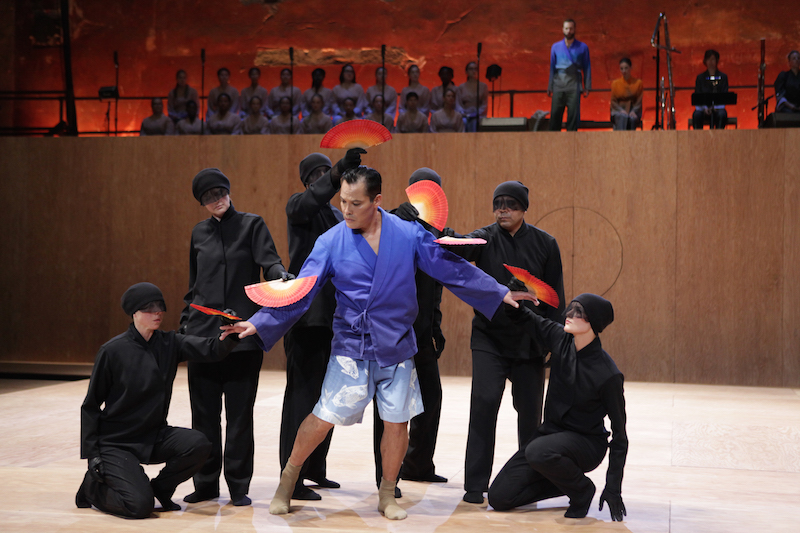
Still, for all its pleasures, Hagoromo is an imperfect and uneven work. In particular, Part 1 (“Prologue: The Heavens”) pales in comparison with Part 2 (“The Earth”). Research into the 15th-century text reveals why: Nothing that happens in the Prologue appears in the original drama. This also explains why the libretto, and thus the choral singing, starts only in the second half. (The libretto is credited to Brendan Pelsue but in fact borrows heavily from Pound’s translations of Zeami’s text.)
In the first part, Whelan, dressed simply in black, enters at the back of the stage in near silence. She moves slowly downstage in a parallel, shuffling walk that Neumann adapts from traditional Noh movement. In contrast to the dancier, more expansive steps she will perform in Part 2, here in the heavens, her movements are mostly earthbound and pedestrian. At one point, two life-size puppets molded on Whelan’s own body and each manipulated by three puppeteers join her, echoing and amplifying her movements. The puppeteers drape the hagoromo over Whelan’s shoulders, and she manipulates the material so that the gold-and-copper-colored fabric drapes beyond her hands like kimono sleeves—or even wings. These are the first intimations of the loftiness and formal grace that will come in Whelan’s dancing in Part 2.
Part 2 opens with a portentous, hypnotic drumming as Tantsits, the tenor who sings the Fisherman’s words, slaps a thick, knotted boat rope against the floor with rhythmically precise timing. This implacable sound charges the atmosphere with suspense and a sense of mysterious ritual. The drumming ends once Soto, the Fisherman, appears onstage. Neumann’s choreography for Soto emphasizes that “solid assurance” and earthy groundedness that Michalek describes in his program note. In a particularly lovely passage, the Fisherman, who rows to sea despite the stormy conditions that accompany the hagoromo’s fall to earth, fights against the gale, indicated musically by a rumbling percussion and cacophony of wind and string instruments. Soto leans from side to side in a series of stylized wind-tossed movements; at one point, the puppeteers hold him by the arms as he slowly pulls away, leaning far off balance with his “oar” (a plain black pole that the puppeteers take at points, waving it like a flagpole or long baton).
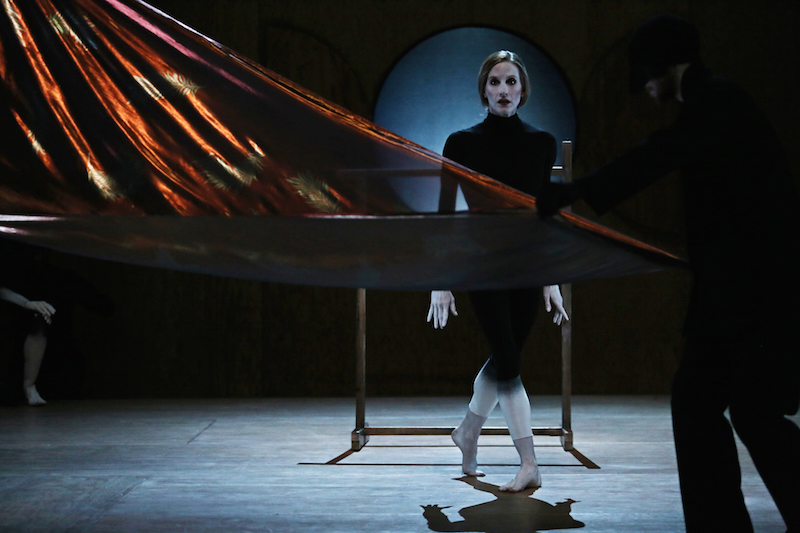
The storm ends, and dawn breaks over a peaceful sea. We hear the sound of birds twittering in the wind instruments as the puppeteers dance with bright orangish-red fans; in their hands, the fans fascinatingly evoke both birds (when fluttered) and the rising of the sun. The unconscious Hakuryo, who has washed up on an island in the bay, wakes and sees the hagoromo hanging from the branches of a pine tree. Tantsits sings: “I approach, / inhale its color / and am aware of mystery. / This cloth is treasure / to be brought home / treasure for my house.”
Whelan’s Angel enters, letting Hakuryo know to whom the hagoromo belongs. And this is when Neumann’s choreography becomes truly interesting. The movements here are often sculptural, with Whelan’s long, thin alabaster limbs making delicate shapes that at times recall the poses of geishas dancing and figures in Japanese art. Even Whelan’s simplest movements etch an impression in space. The choreography draws the viewer’s eye to the long lines of Whelan’s legs and her beautifully arched feet. As the angel weakens without her cloak, she is held by the puppeteers in a broken arabesque position, touching one hand to the floor. The chorus sings: “She is a flower weeping / She is a small bird wilting.”
Once Hakuryo agrees to return the robe, the two dance an extended pas de deux in which Soto at times carries Whelan on his back—the solid earth supporting her airy grace. This duet is the climactic dance moment of the production. But in the libretto (and in the original Noh play), that moment is the final Dance of the Moon, the Suruga-mai, which Hakuryo demands to see as a condition of giving up his treasure. Her dance completed, Whelan exits the stage as Soto watches, motionless. Turning his gaze skyward, he seems to see her ascend to the Palace of the Moon.
It’s a pity that Pelsue, the librettist, chose to cut what is a key passage in the original text. The angel says to Hakuryo:
And for thanksgiving I bequeath
A dance of remembrance to the world,
Fit for the princes of men:
The dance-tune that makes to turn
The towers of the moon,
I will dance it here and as an heirloom leave it
To the sorrowful men of the world.
The passage encapsulates the centrality of the Suruga-mai to this story. Rarely does a dramatic work give dance this much importance. Hagoromo, happily, is an exception to the rule.
Share Your Audience Review. Your Words Are Valuable to Dance.
Are you going to see this show, or have you seen it? Share "your" review here on The Dance Enthusiast. Your words are valuable. They help artists, educate audiences, and support the dance field in general. There is no need to be a professional critic. Just click through to our Audience Review Section and you will have the option to write free-form, or answer our helpful Enthusiast Review Questionnaire, or if you feel creative, even write a haiku review. So join the conversation.




